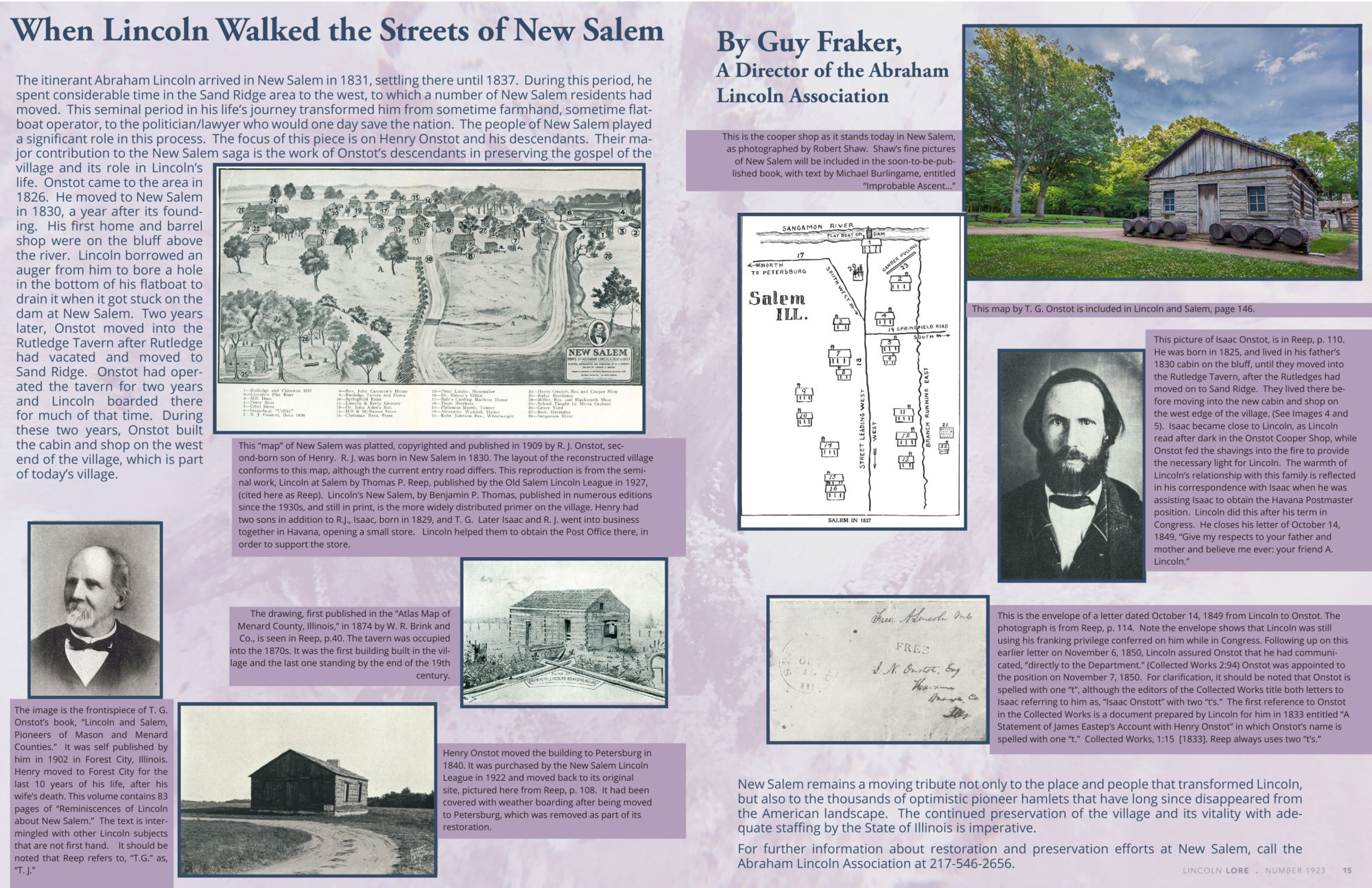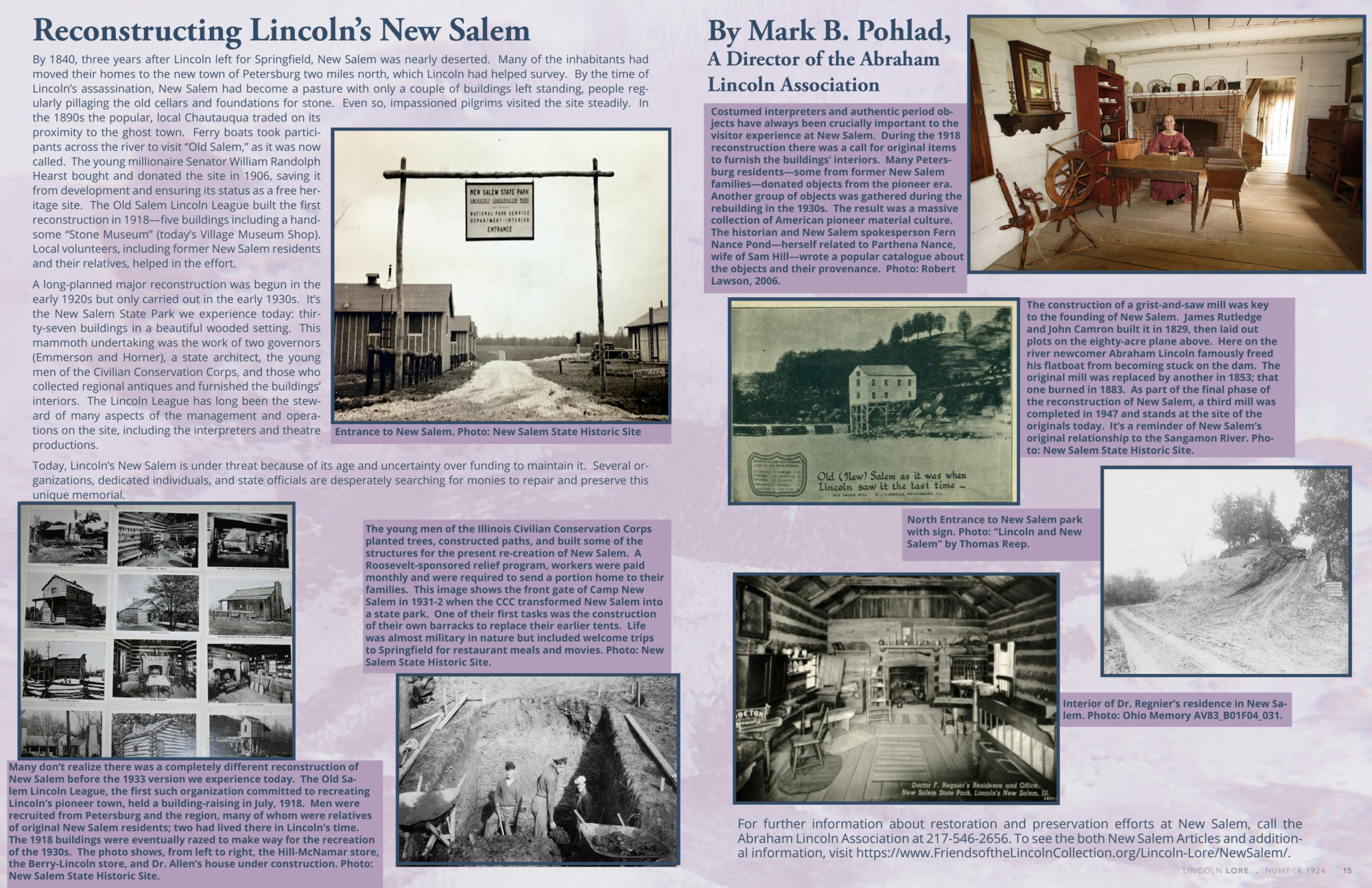New Salem
Spotlight on: New Salem by Guy Fraker and Mark Pohlad
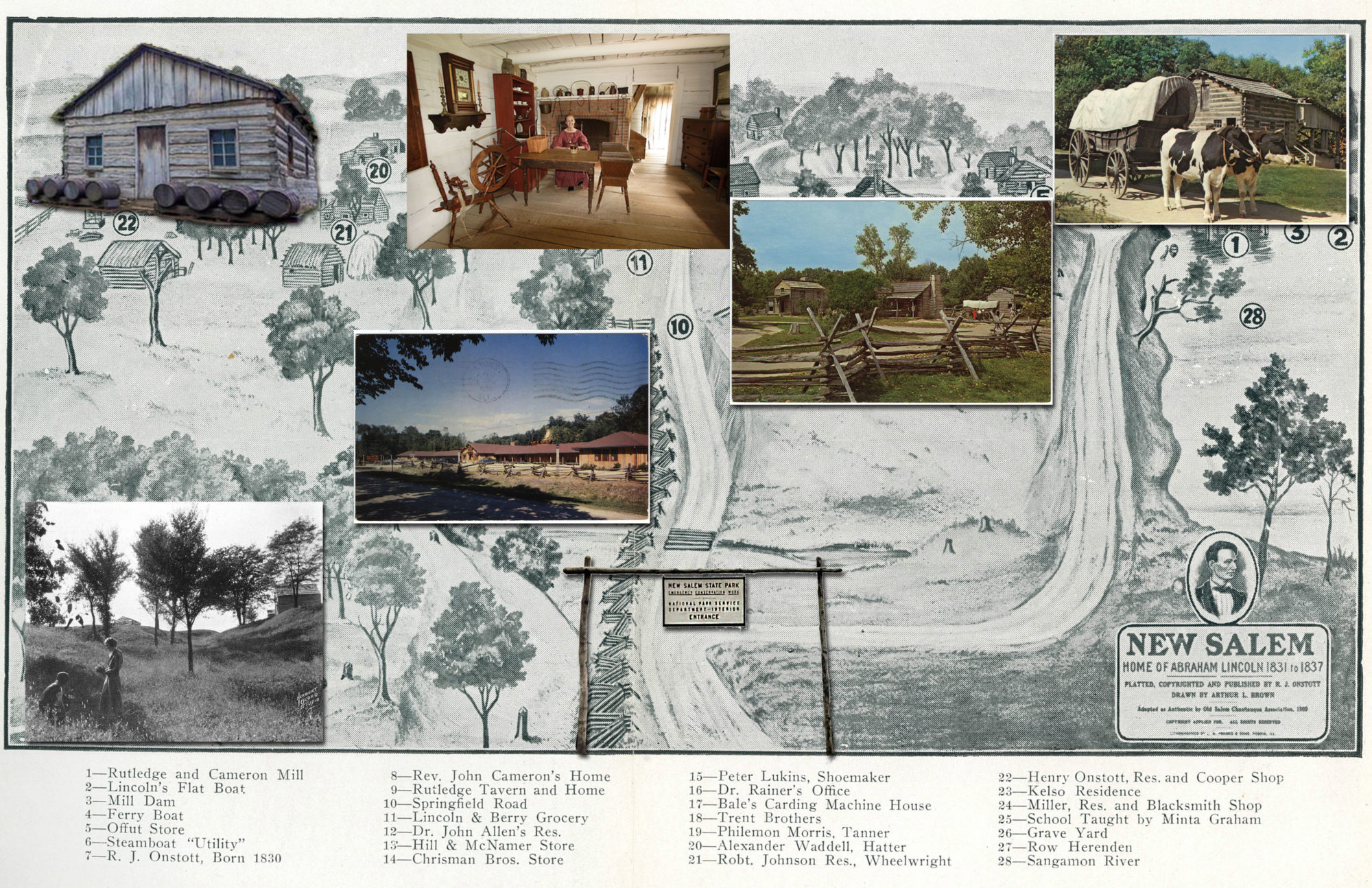
When Lincoln Walked the Streets of New Salem
By Guy Fraker
The itinerant Abraham Lincoln arrived in New Salem 1831, settling there until 1837. During this period, he spent considerable time in the Sand Ridge area to the west, to which a number of New Salem residents had moved. This seminal period in his life’s journey transformed him from sometime farmhand, sometime flatboat operator, to the politician/lawyer who would one day save the nation. The people of New Salem played a significant role in this process. The focus of this piece is on Henry Onstot and his descendants. Their major contribution to the New Salem saga is the work of Onstot’s descendants in preserving the gospel of the village and its role in Lincoln’s life. Onstot came to the area in 1826. He moved to New Salem in 1830, a year after its founding. His first home and barrel shop were on the bluff above the river. Lincoln borrowed an auger from him to bore a hole in the bottom of his flatboat to drain it when it got stuck on the dam at New Salem. Two years later, Onstot moved into the Rutledge Tavern after Rutledge had vacated and moved to Sand Ridge. Onstot had operated the tavern for two years and Lincoln boarded there for much of that time. During these two years, Onstot built the cabin and shop on the west end of the village, which is part of today’s village.
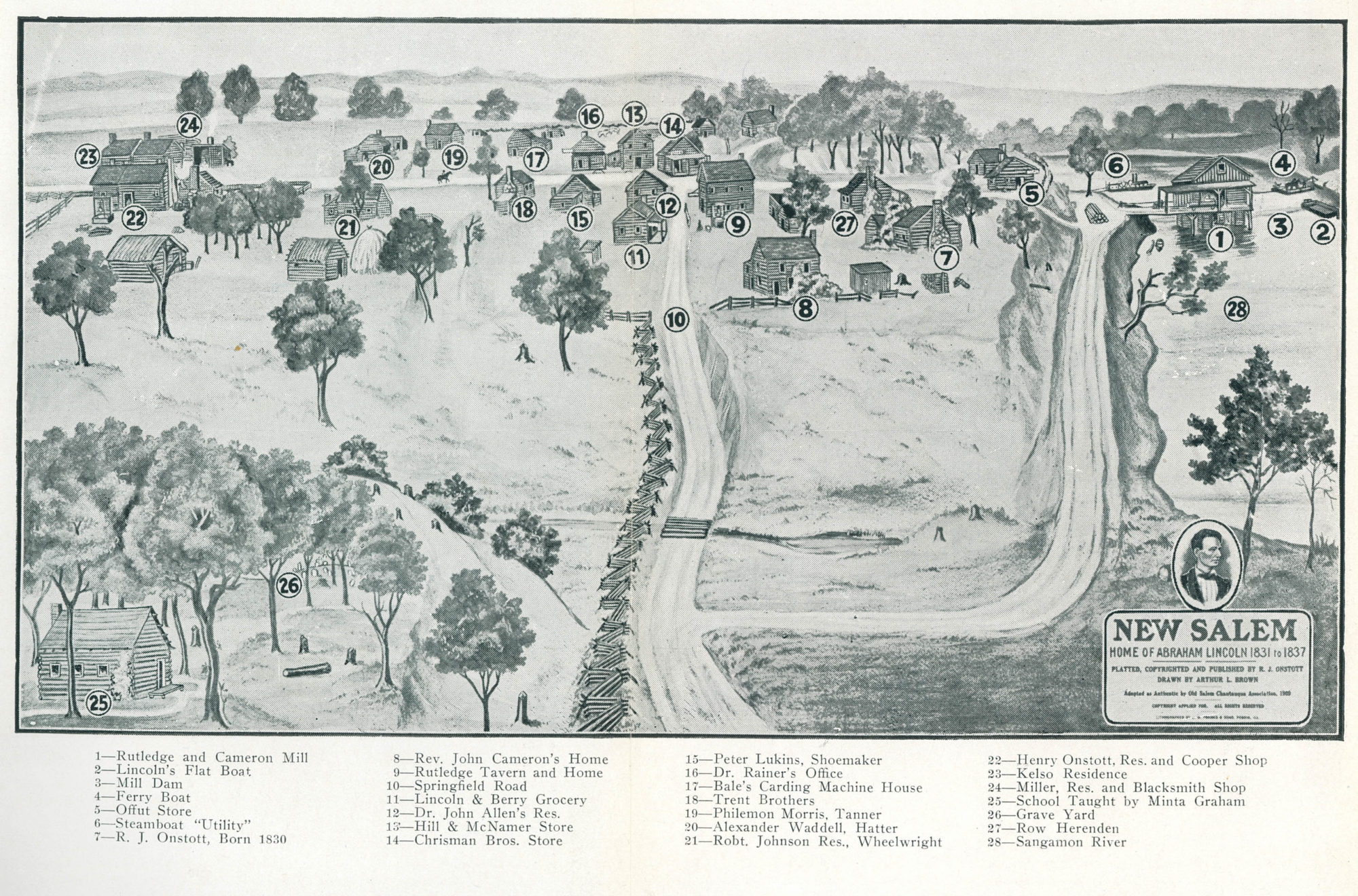
This “map” of New Salem was platted, copyrighted and published in 1909 by R. J. Onstot, second-born son of Henry. R. J. was born in New Salem in 1830. The layout of the reconstructed village conforms to this map, although the current entry road differs. This reproduction is from the seminal work, Lincoln at Salem by Thomas P. Reep, published by the Old Salem Lincoln League in 1927, (cited here as Reep). Lincoln’s New Salem, by Benjamin P. Thomas, published in numerous editions since the 1930’s, and is still in print, is the more widely distributed primer on the village.
Henry had two sons in addition to R.J., Isaac, born in 1829, and T. G. Later Isaac and R. J. went into business together in Havana, opening a small store. Lincoln helped them to obtain the Post Office there, in order to support the store.
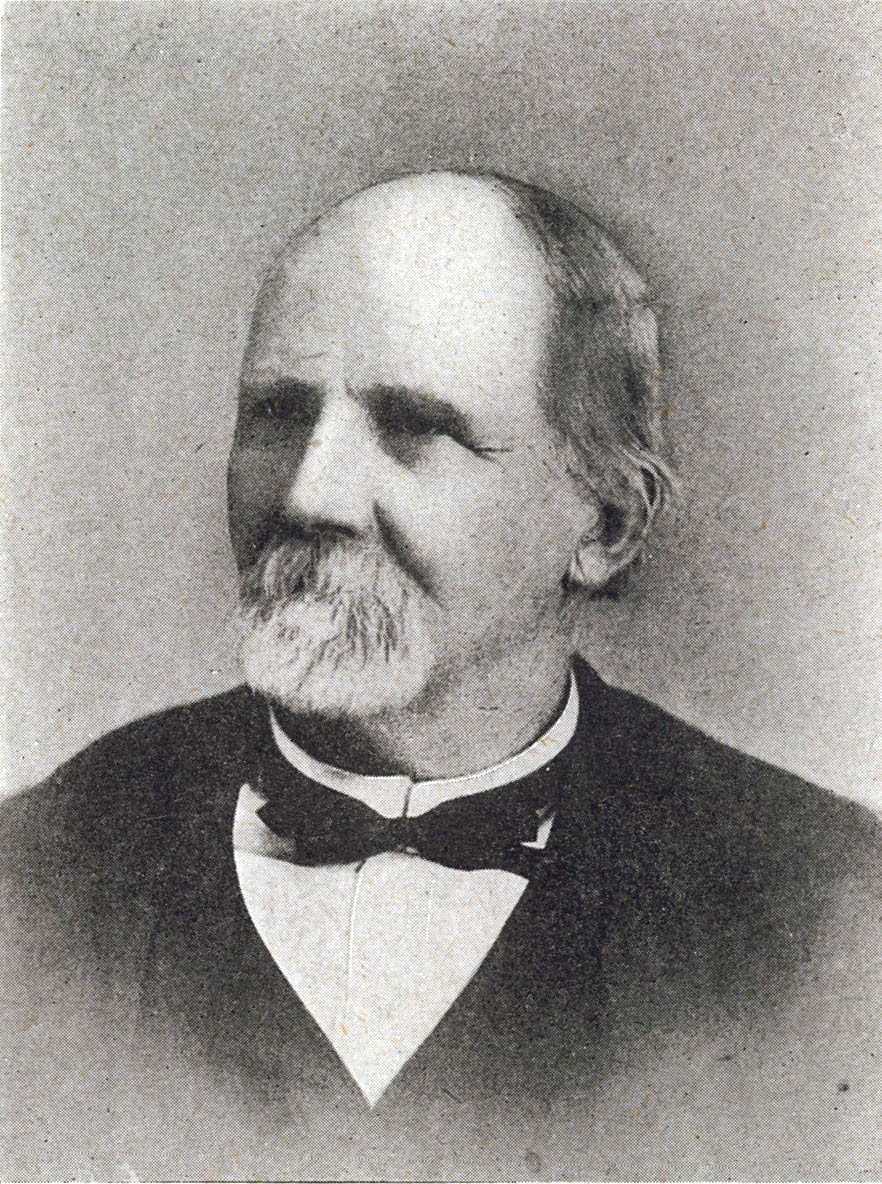
The image is the frontispiece of T. G. Onstot’s book, “Lincoln and Salem, Pioneers of Mason and Menard Counties”, (cited here as, Lincoln and New Salem). It was self published by him in 1902 in Forest City, Illinois. Henry moved to Forest City for the last 10 years of his life, after his wife’s death. This volume contains 83 pages of “Reminiscences of Lincoln about New Salem.” The text is intermingled with other Lincoln subjects that are not first hand. It should be noted that Reep refers to, “T.G.” as, “T. J.”
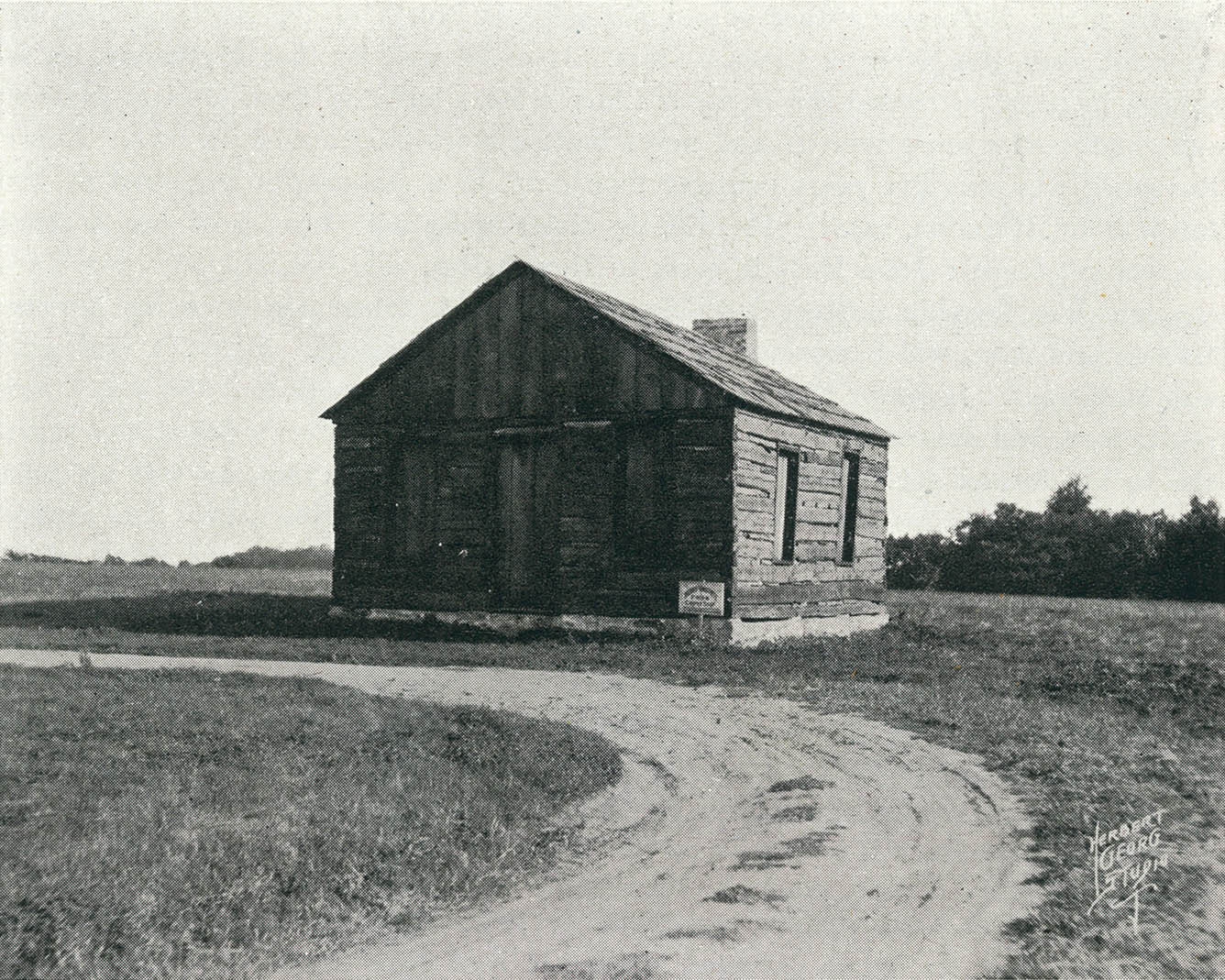
Henry Onstot moved the building to Petersburg in 1840. It was purchased by the New Salem Lincoln League in 1922 and moved back to its original site, pictured here from Reep, p. 108. It had been covered with weather boarding after being moved to Petersburg, which was removed as part of its restoration.
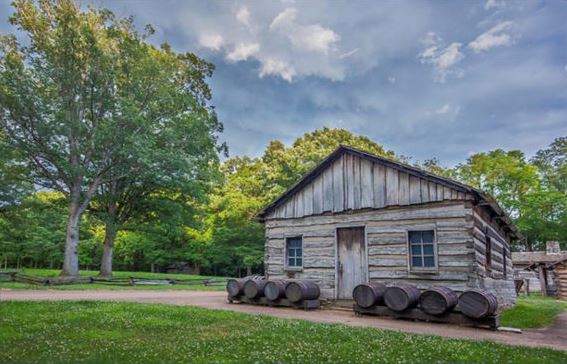
This is the cooper shop as it stands today in New Salem, as photographed by Robert Shaw. Shaw’s fine pictures of New Salem will be included in the soon-to-be-published book, with text by Michael Burlingame, entitled “Improbable Ascent…”
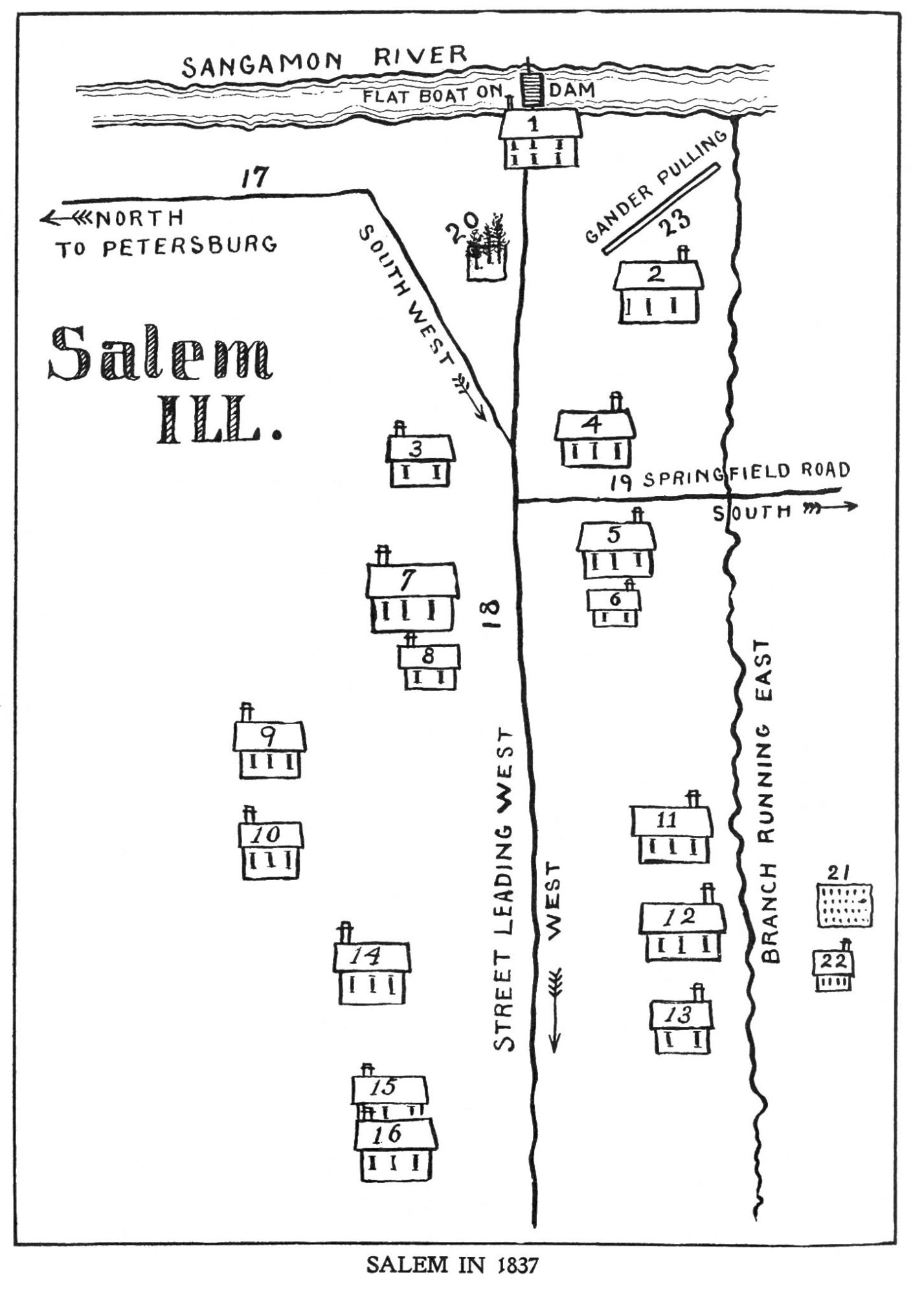
This map by T. G. Onstot is included in Lincoln and Salem, page 146.
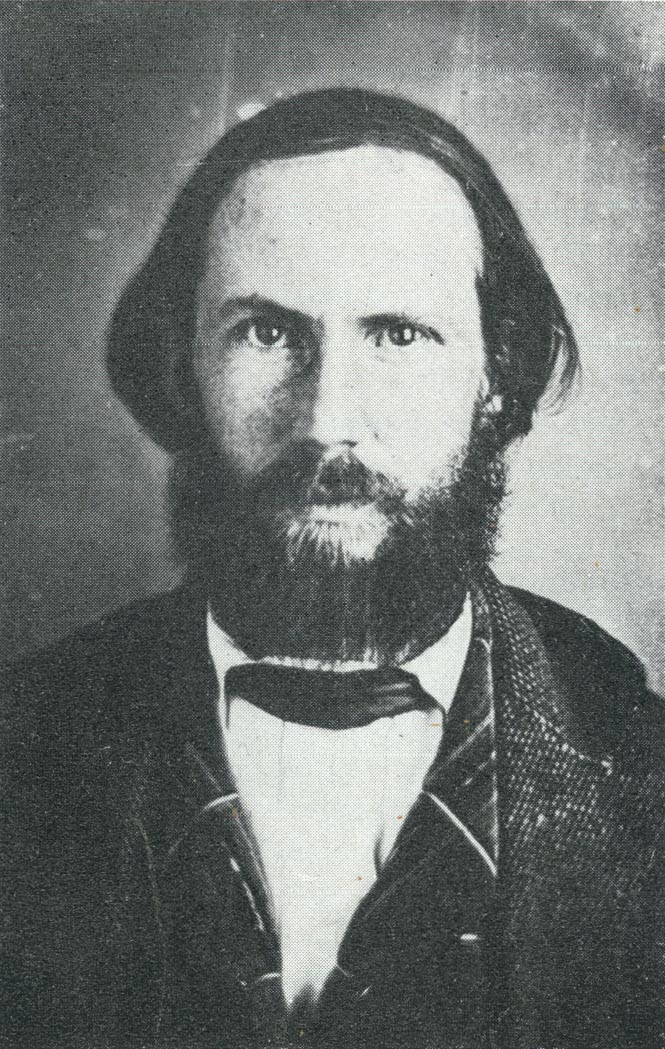
This picture of Isaac Onstot, is in Reep, p. 110. He was born in 1825, and lived in his father’s 1830 cabin on the bluff, until they moved into the Rutledge Tavern, after the Rutledges had moved on to Sand Ridge. They lived there before moving into the new cabin and shop on the west edge of the village. (See Images 4 and 5). Isaac became close to Lincoln, as Lincoln read after dark in the Onstot Cooper Shop, while Onstot fed the shavings into the fire to provide the necessary light for Lincoln. The warmth of Lincoln’s relationship with this family is reflected in his correspondence with Isaac when he was assisting Isaac to obtain the Havana Postmaster position. Lincoln did this after his term in Congress. He closes his letter of October 14, 1849, “Give my respects to your father and mother and believe me ever: your friend A. Lincoln.” (Basler, Roy P., Editor. Collected Works of Abraham Lincoln, volume 2, page 66. Isaac Onstot, hereinafter cited as Collected Works)
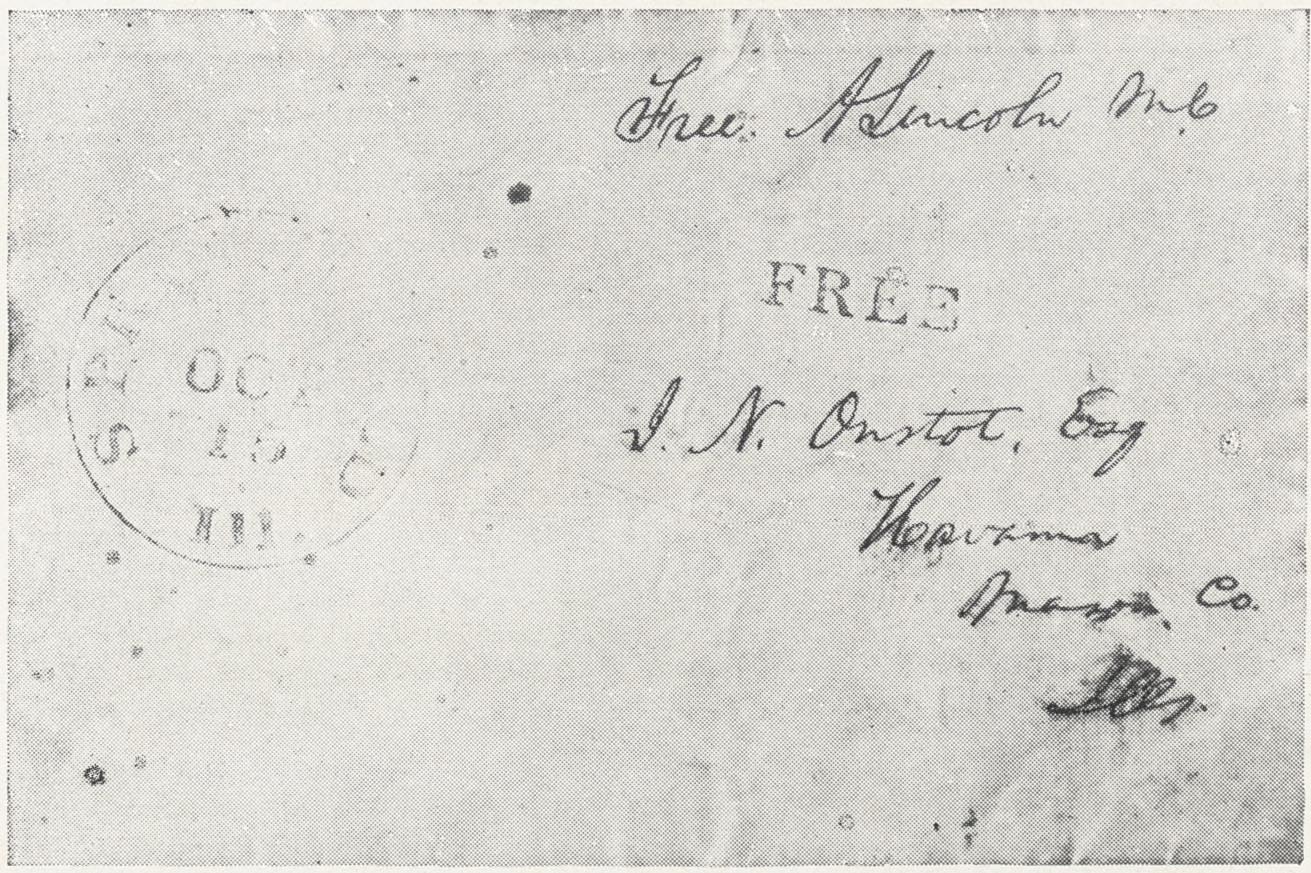
This is the envelope of a letter dated October 14, 1849 from Lincoln to Onstot. The photograph is from Reep, p. 114. Note the envelope shows that Lincoln was still using his franking privilege conferred on him while in Congress. Following up on this earlier letter on November 6, 1850, Lincoln assured Onstot that he had communicated, “directly to the Department.” (Collected Works 2:94) Onstot was appointed to the position on November 7, 1850. For clarification, it should be noted that Onstot is spelled with one “t”, although the editors of the Collected Works title both letters to Isaac referring to him as, “Isaac Onstott” with two “t’s.” The first reference to Onstot in the Collected Works is a document prepared by Lincoln for him in 1833 entitled “A Statement of James Eastep’s Account with Henry Onstot” in which Onstot’s name is spelled with one “t.” Collected Works, 1:15 [1833]. Reep always uses two “t’s.”
New Salem remains a moving tribute not only to the place and people that transformed Lincoln, but also to the thousands of optimistic pioneer hamlets that have long since disappeared from the American landscape. The continued preservation of the village and its vitality with adequate staffing by the State of Illinois is imperative.
Citations:
Map of New Salem Home of Abraham Lincoln, 1831-1837.
Platted, copyrighted and published by R. J. Onstot.
Drawn by Arthur L. Brown.
Adapted as authentic by the Old Salem Chautauqua Association.
The title page of the Reep book is: “Lincoln at New Salem” by Thomas P. Reep for the Old Salem Lincoln League, incorporated Petersburg, Illinois, copyright 1927.
Reconstructing Lincoln’s New Salem
Mark B. Pohlad
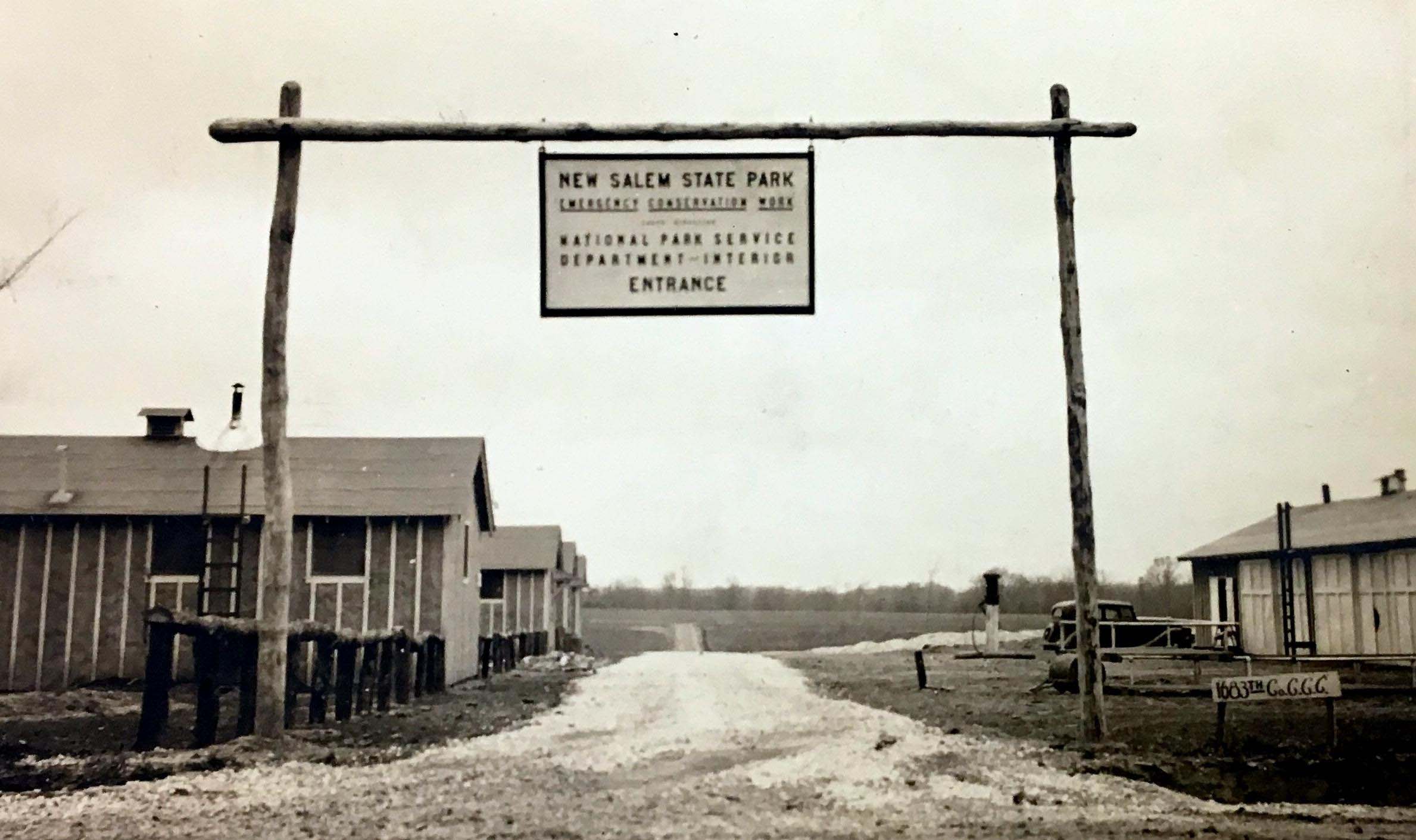
By 1840, three years after Lincoln left for Springfield, New Salem was nearly deserted. Many of the inhabitants had moved their homes to the new town of Petersburg two miles north, which Lincoln had helped survey. By the time of Lincoln’s assassination, New Salem had become a pasture with only a couple buildings left standing, people regularly pillaging the old cellars and foundations for stone. Even so, impassioned pilgrims visited the site steadily. In the 1890s the popular, local Chautauqua traded on its proximity to the ghost town. Ferry boats took participants across the river to visit “Old Salem,” as it was now called. The young millionaire Senator William Randolph Hearst bought and donated the site in 1906, saving it from development and ensuring its status as a free heritage site. The Old Salem Lincoln League built the first reconstruction in 1918––five buildings including a handsome “Stone Museum” (today’s Village Museum Shop). Local volunteers, including former New Salem residents and their relatives helped in the effort.
A long-planned major reconstruction was begun in the early 1920s but only carried out in the early 1930s. It’s the New Salem State Park we experience today: thirty-seven buildings in a beautiful wooded setting. This mammoth undertaking was the work of two governors (Emmerson and Horner), a state architect, the young men of the Civilian Conservation Corps, and those who collected regional antiques and furnished the buildings’ interiors. The Lincoln League has long been the stewards of many aspects of the management and operations on the site including the interpreters and theatre productions.
Today, Lincoln’s New Salem is under threat because of its age and uncertainty over funding to maintain it. Several organizations, dedicated individuals, and state officials are desperately searching for monies to repair and preserve this unique memorial.
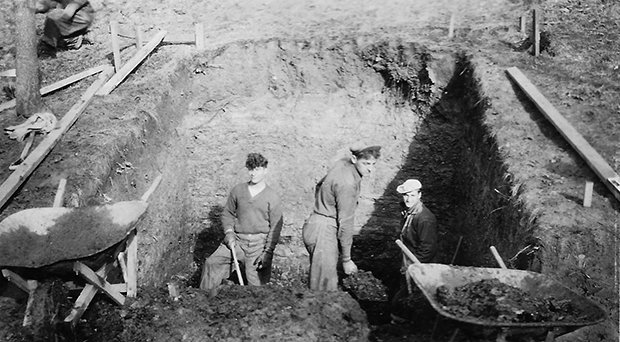
CCC “Camp New Salem”
The young men of the Illinois Civilian Conservation Corps planted trees, constructed paths, and built some of the structures for the present recreation of New Salem. A Roosevelt-sponsored relief program, workers were paid monthly and were required to send a portion home to their families. This image shows the front gate of Camp New Salem in 1931-2 when the CCC transformed New Salem into a state park. One of their first tasks was the construction of their own barracks to replace their earlier tents. Life was almost military in nature but included welcome trips to Springfield for restaurant meals and movies.

Many don’t realize there was a completely different reconstruction of New Salem before the 1933 version we experience today. The Old Salem Lincoln League, the first such organization committed to recreating Lincoln’s pioneer town, held a building-raising in July, 1918. Men were recruited from Petersburg and the region, many of whom were relatives of original New Salem residents; two had lived there in Lincoln’s time. The 1918 buildings were eventually razed to make way for the recreation of the 1930s. The photo shows, from left to right, the Hill-McNamar store, the Berry-Lincoln store, and Dr. Allen’s house under construction.
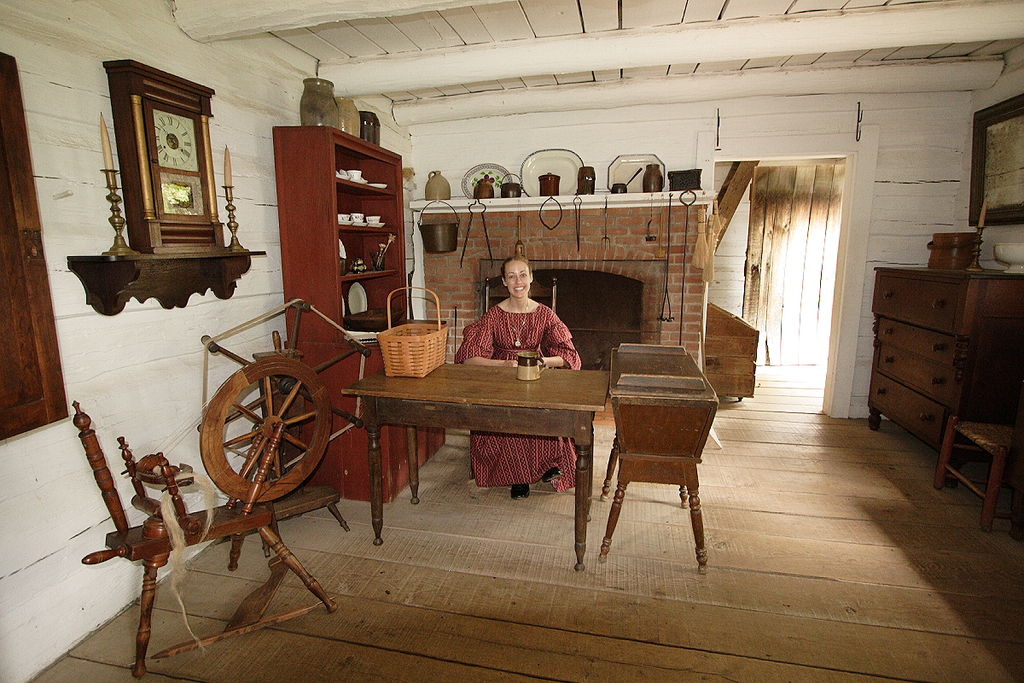
The interior of the Sam Hill residence. Photo by Robert Lawton, 2006.
Costumed interpreters and authentic period objects have always been crucially important to the visitor experience at New Salem. During the 1918 reconstruction there was a call for original items to furnish the buildings’ interiors. Many Petersburg residents—some from former New Salem families—donated objects from the pioneer era. Another group of objects was gathered during the 1930s rebuilding. The result was a massive collection of American pioneer material culture. The historian and New Salem spokesperson Fern Nance Pond—herself related to Parthena Nance, wife of Sam Hill––wrote a popular catalogue about the objects and their provenance.
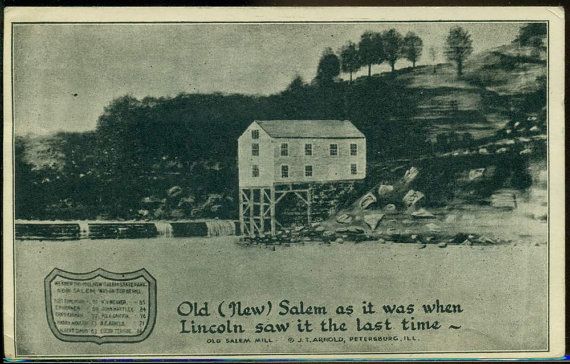
Grist-and-Saw Mill
The construction of a grist-and-saw mill was key to the founding of New Salem. James Rutledge and John Camron built it in 1829, then laid out plots on the eighty-acre plane above. Here on the river newcomer Abraham Lincoln famously freed his flatboat from becoming stuck on the dam. The original mill was replaced by another in 1853; that one burned in 1883. As part of the final phase of the reconstruction of New Salem, a third mill was completed in 1947 and stands at the site of the originals today. It’s a reminder of New Salem’s original relationship to the Sangamon River.
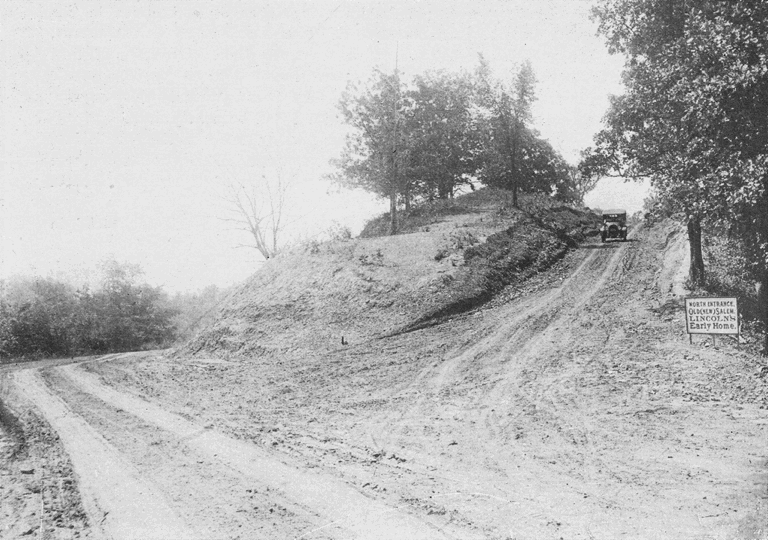
North Entrance to New Salem park with sign. Photo: “Lincoln and New Salem” by Thomas Reep.
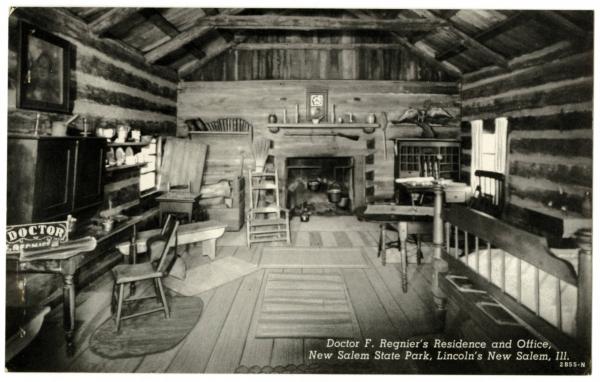
Interior of Dr. Regnier’s residence in New Salem. Photo: Ohio Memory AV83_BO1FD04_031.
For further information about restoration and preservation efforts at New Salem, call the Abraham Lincoln Association at 217-546-2656.

